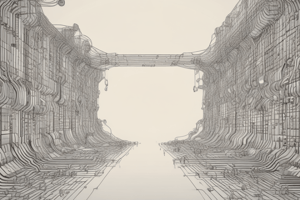Podcast
Questions and Answers
What should be done when inserting a new node at a specified position in a linked list?
What should be done when inserting a new node at a specified position in a linked list?
- The previous node's next should point to null.
- Next of the previous node should point to the new node and new node's next should point to the previous's next. (correct)
- Only the previous node needs to be updated.
- The new node should be set as the head of the linked list.
What is the first action to take when searching for an element in a linked list?
What is the first action to take when searching for an element in a linked list?
- Check if the head node is the search value.
- Traverse the list without tracking the index.
- Start from the last node of the list.
- Create a temp node pointing to the head. (correct)
Which condition initiates the deletion of the first node in a linked list?
Which condition initiates the deletion of the first node in a linked list?
- The head's next node is not null.
- The list has more than one node.
- The temp node is empty.
- The head is not null. (correct)
What must be checked before deleting the last node of a linked list?
What must be checked before deleting the last node of a linked list?
When deleting a node at a given position in a linked list, what should the specified position be greater than or equal to?
When deleting a node at a given position in a linked list, what should the specified position be greater than or equal to?
What is a primary disadvantage of linked lists compared to arrays?
What is a primary disadvantage of linked lists compared to arrays?
Which of the following statements about singly linked lists is true?
Which of the following statements about singly linked lists is true?
In a linked list, what is the function of pointers in each node?
In a linked list, what is the function of pointers in each node?
What is a characteristic of circular doubly linked lists?
What is a characteristic of circular doubly linked lists?
Which of the following is NOT an advantage of linked lists?
Which of the following is NOT an advantage of linked lists?
What does the 'HEAD' node represent in a linked list?
What does the 'HEAD' node represent in a linked list?
What is the main reason why linked lists are better than arrays in terms of memory utilization?
What is the main reason why linked lists are better than arrays in terms of memory utilization?
What is the first step when inserting a new node at the start of a linked list?
What is the first step when inserting a new node at the start of a linked list?
What is the purpose of the TraverseList function?
What is the purpose of the TraverseList function?
How is a new node added at the end of the linked list?
How is a new node added at the end of the linked list?
When inserting a new node at a given position, what must be checked before proceeding?
When inserting a new node at a given position, what must be checked before proceeding?
What happens if the temp node is null when trying to traverse the linked list?
What happens if the temp node is null when trying to traverse the linked list?
Which operation directly removes the head node from the linked list?
Which operation directly removes the head node from the linked list?
To insert a new node at the start, what must be done to the head pointer?
To insert a new node at the start, what must be done to the head pointer?
In which scenario is the new node made to head when inserting at a given position?
In which scenario is the new node made to head when inserting at a given position?
What should be done if the list contains no items at the beginning of traversal?
What should be done if the list contains no items at the beginning of traversal?
What is a key characteristic of traversing a linked list?
What is a key characteristic of traversing a linked list?
Flashcards
What is a linked list?
What is a linked list?
A linear data structure where elements are stored in nodes. Each node has a data part containing the element's value and a next part referencing the following node.
What is the HEAD node?
What is the HEAD node?
The first node in a linked list. Serves as the starting point for traversing the list.
What is the TAIL node?
What is the TAIL node?
The last node in a linked list. It does not point to a subsequent node, denoted as NULL.
What is a singly linked list?
What is a singly linked list?
Signup and view all the flashcards
What is a doubly linked list?
What is a doubly linked list?
Signup and view all the flashcards
What is a circular linked list?
What is a circular linked list?
Signup and view all the flashcards
What is a circular doubly linked list?
What is a circular doubly linked list?
Signup and view all the flashcards
Inserting a new node at a specified position
Inserting a new node at a specified position
Signup and view all the flashcards
Searching an element in a linked list
Searching an element in a linked list
Signup and view all the flashcards
Deleting the first node
Deleting the first node
Signup and view all the flashcards
Deleting the last node
Deleting the last node
Signup and view all the flashcards
Deleting a node at the given position
Deleting a node at the given position
Signup and view all the flashcards
Inserting a new node at the start of a linked list
Inserting a new node at the start of a linked list
Signup and view all the flashcards
Traversing a linked list
Traversing a linked list
Signup and view all the flashcards
Inserting a new node at the end of a linked list
Inserting a new node at the end of a linked list
Signup and view all the flashcards
Inserting a new node at a given position in a linked list
Inserting a new node at a given position in a linked list
Signup and view all the flashcards
Deleting the first node in a linked list
Deleting the first node in a linked list
Signup and view all the flashcards
Deleting the last node in a linked list
Deleting the last node in a linked list
Signup and view all the flashcards
Deleting a node at a given position in a linked list
Deleting a node at a given position in a linked list
Signup and view all the flashcards
Deleting all nodes in a linked list
Deleting all nodes in a linked list
Signup and view all the flashcards
Counting nodes in a linked list
Counting nodes in a linked list
Signup and view all the flashcards
Reversing a linked list
Reversing a linked list
Signup and view all the flashcards
Study Notes
Linked List
- A linked list is a linear data structure where elements are stored in nodes.
- Each node has two sub-elements: a data part storing the element's value and a next part storing a pointer to the next node.
- Linked lists are dynamic, allocating memory as needed.
- Insertion and deletion are efficient.
- Other data structures (like stacks and queues) can be implemented using linked lists.
- Access time is faster than some other structures, and it can be expanded in constant time without extra memory.
- Memory usage is efficient as there's no need to predetermine the list size.
- Backtracking is possible in doubly linked lists.
- Random access is not allowed (sequential access required).
- Linked lists are less memory-intensive for large elements compared to arrays.
- Wasted memory exists in the form of pointers within each node.
- The first node (HEAD) is used as a reference point.
- The last node points to NULL (tail).
- Linked lists can be visualized as a chain of nodes.
Types of Linked Lists
- Singly Linked List: Traversal is only forward.
- Doubly Linked List: Traversal is both forward and backward.
- Circular Singly Linked List: The last element points to the first element.
- Circular Doubly Linked List: Both the last and first elements point to each other.
Linked List Operations
- Insert a node at the start
- Insert a new node at the end
- Insert a node at a given position
- Traverse the linked list
- Search for a node
- Delete a node (first node)
- Delete a node (last node)
- Delete a node at a given position
- Delete all nodes
- Count the nodes
- Reverse the list
- Update the list
Insert a new node at the start
- A new node with the given element is created.
- The new node is added before the existing head of the list.
- The head pointer is updated to point to the new node.
Traverse Linked List
- A temporary (
temp) node is created, pointing to the head of the list. - If the
tempnode is not null, display its content and move to the next node usingtemp.next. - Repeat this process until
tempbecomes null. - If
tempis null at the start, the list is empty.
Insert a new node at the end
- A new node with the given element is created.
- The last node in the list is found (
temp). - The
nextpointer of the last node is linked to the new node.
Insert a new node at the given position
- A new node with the given element is created.
- If the position is 1, make the new node the head.
- Otherwise, traverse to the node before the desired position (
temp). - Update links to insert the new node at the specified position.
- Handle cases where the position is invalid or the list is empty.
Search Element
- A temporary node is created pointing to the head.
- Variables (
found,i) are used to track search progress. - If the
tempnode is not null:- Traverse the list, checking if the current node's value matches the search value.
- If a match is found, update
foundand exit the loop.
- If
foundis 1, display the element and index; otherwise, say it's not found. - If the
tempnode is null at the start, the list is empty.
Delete the first node
- If head is not null, create a temporary node pointing to head.
- Move head to the next node of head
- Delete the temporary node.
Delete the last node
- Check if the head is empty.
- If the head is not empty, check if
head.nextis empty.- If it is, release the head.
- Otherwise, traverse to the second-to-last node.
- Link the
nextof the second-to-last node toNULLand delete the last node.
Delete a node at the given position
- Check if the position is valid (greater than or equal to 1).
- If position is 1 and head is not null, make the head next as head and delete the previous head.
- Else, traverse to the node before the specified position.
- If previous node and the node to be deleted exist, adjust links.
- Handle cases where the position is invalid or the node does not exist.
Studying That Suits You
Use AI to generate personalized quizzes and flashcards to suit your learning preferences.





